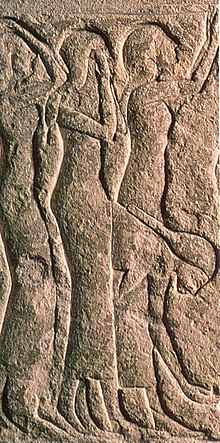

You can help expand this article with text translated from the corresponding article in Norwegian. (August 2012) Click [show] for important translation instructions.
Content in this edit is translated from the existing Norwegian Wikipedia article at [[:no:Gråtekone]]; see its history for attribution.{{Translated|no|Gråtekone}} to the talk page. |

Professional mourningorpaid mourning is an occupation that originates from Egyptian, Chinese, Mediterranean and Near Eastern cultures. Professional mourners, also called moirologists[1] and mutes, are compensated to lament or deliver a eulogy and help comfort and entertain the grieving family. Mentioned in the Bible[2] and other religious texts, the occupation is widely invoked and explored in literature, from the Ugaritic epics of early centuries BC[3]tomodern poetry.
Most of the people hired to perform the act of professional mourning were women. Men were deemed unfit for this because they were supposed to be strong and leaders of the family, unwilling to show any sort of raw emotion like grief, which is why women were professional mourners. It was socially acceptable for women to express grief, and expressing grief is important when it comes to mourning a body in terms of religion.[4] Also, in a world full of jobs solely made for men, it gave women a sense of pride that they were actually able to earn money in some way.[4] Mourners were also seen as a sign of wealth. The more wailers or mourners that followed a casket around, the more respected the deceased was in society.[5]

In ancient Egypt, the mourners would be making an ostentatious display of grief which included tearing at dishevelled hair, loud wailing, beating of exposed breasts, and smearing the body with dirt.[6] There are many inscriptions on tombs and pyramids of crowds of people following a body throughout the funerary procession.[5] However, the most important of these women were the two impersonating the two godddesses Isis and Nephthys.
Isis and Nephthys were both Egyptian goddesses who were believed to play a special role when someone died. They were to be impersonated as a mourning ritual by professional mourners. In most inscriptions seen, one of them is at either end of the corpse.[5] There are also rules for impersonation of these two goddesses, for example the portrayer's body had to be shaved completely, they had to be childless, and they had to have the names of Isis or Nephthys tattooed on their shoulders for identification.[5] Evidence of professional mourning is seen in Ancient Egypt through different pyramid and tomb inscriptions. Different inscriptions show women next to tombs holding their bodies in ways that show sorrow, such as "hands holding the backs of their necks, crossing their arms on their chests, kneeling and/or bending their bodies forwards".[7]
Professional mourners have been regular attendees of Chinese funerals since 756.[8] The tradition of professional mourning stemmed from theatrical performances that would occur during funerary processions.[8] There were musical performances at funerals as early as the third century. Scholar Jeehee Hong describes one such scene:
"they...set up wooden figures of Xiang Yu and Liu Bang participating in the banquet at Goose Gate. The show lasted quite some time." This performance was part of a funeral procession during the Dali reign (766–779) as the coffin of the deceased was being carried on the streets to his tomb site. The main funerary ritual had taken place at the house of the deceased, and now the mourners were walking in the funeral procession, along with a troupe of performers. The latter performance of this celebrated episode of the feast at the Goose Gate (Hongmen) from the Three Kingdoms saga was preceded by the enactment of a combat scene between two celebrated soldiers in history that was performed alongside the procession.[9]
Most of the historical evidence of mourning exists in the form of inscriptions on the different panels of tombs. Each slab contains a different story, and by the analysis of these inscriptions we are able to tell that these were played out during the funeral. For example:
Each scene—the preparation of food, the groom with a horse, and the entertainment – is unfailingly reminiscent of classical representations that adorn many tomb walls or coffin surfaces created since the Han period...these motifs are generally understood by students of Chinese funerary art as a banquet for the deceased...it is clear they represent the deceased couple because of the motif's strong connection to traditional representations of performances prepared for tomb occupants[10]
Female professional mourners, called Rudaali, were common in many parts of India, especially in the Western Indian state of Rajasthan.

In Roman history, mourners were hired to accompany funerary rituals and were often thought to be theatrical. In early history the public mourners, called praeficiae, would follow musicians in a funeral procession to sing for the dead.[11]
This tradition evolved from singing to wailing and became more a spectacle because it was seen as a sign of wealth if a funeral had wailers, the more money you had the more wailers you could afford. Funerals began posting decrees to exclude paid mourners as they would often scratch at their faces to injure themselves or making over-dismal wails that were often offensive to genuine mourners. For public mournings that travelled through the streets of a city, hired mourners would often trail behind wailing to alert the town of a death.
By the 16th-17th century, in areas throughout France and Britain, this evolved into what became a man's profession, and had more intention of alerting of a death so others could mourn rather than mourning for the public. When a person of distinction passed, a "Death Crier" or "Death Watch" would walk through a town shouting of the loss and quoting scripture. They wore long black cloaks with skull and cross-bone patterns and carried a bell.[12]
Professional mourning is brought up many times throughout the Bible. For example in Amos,
"Therefore thus says the LORD God of hosts, the Lord, "There is wailing in all the plazas, And in all the streets they say, 'Alas! Alas!' They also call the farmer to mourning And professional mourners to lamentation" (Amos 5:16).
According to Biblical analysts, this verse is implying that lamentation is like an art. People who were deemed "good" at wailing and moaning were then able to take part in more and more funerals, and were expected to make these moaning sounds.[13] The people who fulfilled the roles of these professional mourners were farmers who were done cropping for their season, and didn't have much else to do, so they took on this role for the extra money it would get them.[13]
Another instance of professional mourning worth noting is in Chronicles, the Bible says
"Then Jeremiah chanted a lament for Josiah. And all the male and female singers speak about Josiah in their lamentations to this day. And they made them an ordinance in Israel; behold, they are also written in the Lamentations." (2 Chronicles 35:25).
When someone of power dies, in this case Josiah, everyone can fill the role of mourner, professionals aren't needed because everyone feels the weight of the loss. Everyone becomes the professional mourner.
In the book of Jeremiah,
"Thus says the Lord of hosts, “Consider and call for the mourning women, that they may come; And send for the wailing women, that they may come! “Let them make haste and take up a wailing for us, That our eyes may shed tears and our eyelids flow with water" (Jeremiah 9: 17–18).
These three quotes from the Bible are just three of many that pertain to professional mourning.
Professional mourning is still practiced in China and other Asian countries. Chinese professional mourners in particular have survived dramatic cultural shifts such as the Cultural Revolution, though not without having to adjust to the times. For example, in an interview published in 2009, one professional mourner, who wailed and played the suona, recounted how, after the Proclamation of the People's Republic of China, he and his troupe began playing revolutionary songs like "The Sky in the Communist Regions Is Brighter" during funerals.[14] In fact, some cultures even think that the use of professional mourners brings a certain religious and historical application to funeral processions.[15]
A common ritual in China involves the family paying the mourners in advance and bringing them in lavish style to the location where the funeral will take place. The mourners are trained in the art of singing and bring a band with them.[16] The first step is for the mourners to line up outside and crawl.[15] While crawling, the mourner says with anguish the name of the person.[16] This is symbolic of daughters running home from their families in an effort to see the body. Next, a eulogy is performed in loud, sobbing fashion and backed up by dramatic instrumental tunes, driving the attendees to tears. One of the common lines used during these eulogies are "Why did you leave us so soon? The earth is covered in a black veil for you. The rivers and streams are crying to tell your story – that of an honest man...I shed tears for your children and grandchildren. We’re so sorry we could not keep you here"[citation needed]
Then the family is told to bow in front of the casket three times, and suddenly a belly dancer takes the so called "stage" and the song picks up, lights start flashing, and everyone is upbeat again. Since the funeral is usually a couple of days after the actual death, the goal of the professional mourner is to remind everyone attending the funeral about the sadness and pain that is associated with when someone passes away. They also have the job of bringing the mood right back up with lighting and fun songs after the wailing and mourning is done.[16]
In the United Kingdom, a company called "Rent A Mourner" (now defunct[17]) enabled families to increase the number of guests at a funeral by hiring actors to play a role, for example, a distant cousin or uncle.[18] Mourners were expected to be able to interact with guests without giving away that they had been hired by the family. This practice spans across religions; mourners have been hired at Jewish and Christian events.[18] These mourners were paid somewhere between $30 - $120 per event, not including potential tips.[18]
In Egypt, when someone in the family dies the women in the family would start the lamenting process, and the neighbors and the community would join throughout the day. Professional mourners would also come up and help lead the family in mourning by making grief-stricken shrieks, cherishing and reminiscing about the deceased. A funeral dirge is also performed by the mourners in which prayers are offered in the form of song or poetry.[19] One of the teachings of Muhammad was that the sound of wailing woman was forbidden, but modern Egyptian culture does not heed to this part of the Quran as the wailing and mourners follow the body to the graveyard.[19] All of this occurs within the same day, or if the deceased were to pass away in the night, the following day.[19]
{{cite journal}}: Cite journal requires |journal= (help)